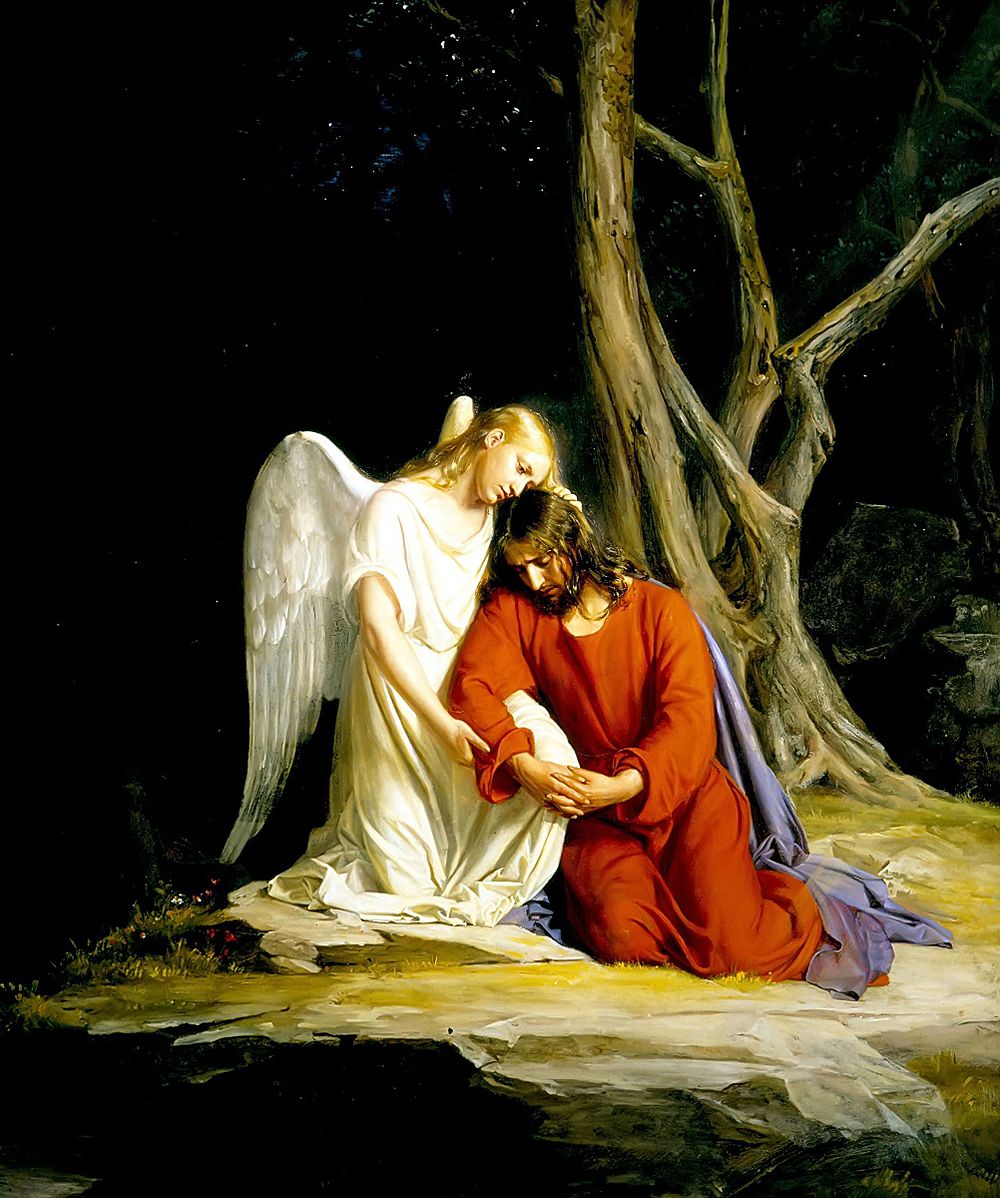Palm Sunday seems a little sad to me. My daughter Jess died ten years ago. Since then I no longer see Holy Week in quite the same way.
Today, two thousand years after that first Passion Week, we enjoy the luxury of knowing how the story of Jesus continues through Easter morning. This was not the case for Christ’s followers in those heady times.
Surely the last month of Christ’s life was filled with expectation. Some of his followers may have seen in Jesus the earthly messiah of Jewish tradition, poised to usher in a new kingdom of jubilee and freedom. Others might have perceived, however dimly at first, his divine nature and the mystery of Incarnation. For all of them, it was a time of miracles. Joy was in the air.
Consider Jesus’ triumphal entry into Jerusalem, the expectations of so many placed like the palms before him. Soon those fronds would be trampled, fond hopes dashed. By the end of the week there is suffering in Gethsemane, ignominy at an unjust trial, and excruciating torture on Calvary. Those who hailed Jesus only days before were faced with hurt, fear, anger, betrayal, disappointment, and a reasonable concern that perhaps, after all, they had been duped.
Just as the followers of Jesus mourned his Friday death on Holy Saturday, I too look back at the wondrous days of my daughter’s life. My personal Palm Sundays, in a way.
I recall holding Jess in my arms the moment she was born, even before her mother was capable of taking her weight, perhaps the first true Palm Sunday of my life. I remember displays of Jess’s art work in her first gallery opening, a private Palm Sunday in anticipation of a future that, alas, was not to be.
“So full of hope,” keened Jess’s mother after her death. Today these Palm Sundays have been replaced by a lifetime of Holy Saturdays, aptly known as Black Saturdays, one after another, as I wake each morning to a world without Jess in it.
Is there hope in Palm Sunday for the grieving? Not much, maybe. Jesus died, as our loved ones died. He returned. But our dead have not. Easter Sunday is not our ending. Not yet.
In this life, each week seems to end on Holy Saturday. We wait for a day, the other side of death, when we will hold our loved ones in our arms again. Because of this, not just Easter, but the entire season of Lent may seem like a burden for mourners.
Traditionally the forty-six days of Lent from Ash Wednesday to Holy Saturday are associated with fasting, giving to those in need, self-denial, prayer, and penitence. This period is symbolic of Christ’s sojourn in the desert, leading to a practice among believers of foregoing something we enjoy. Such customs are intended to encourage reflection, searching, and spiritual preparation for Easter Sunday.
For the grieving, this might seem to miss the point. What earthly sacrifice is greater than the loss of our loved ones? Which prayer speaks louder than our desperate wordless keening? Is any penitence greater than the remorse and guilt known to all who mourn? Do we really care about giving up soda, naps, posting on social media, or our favorite television program? Clinical social worker and bereaved parent Harriet Sarnoff Schiff suggests that many daily concerns lose significance after a death. “For most of us, the worst is behind us,” she writes. After that, little in this life carries the same weight.
Lent is also a time of submission to the divine. “The face of God shown here is of a Lord near at hand, ready to forgive, a god of Grace,” says Hebrew Bible scholar Walter Brueggemann of Lent. “But this is a God to whom a turn must be made, a God of demand, a God of demand ready to be a God of grace.” This is not easy, he adds. As with all serious relationships, work is required. Most of us would agree.
Yet in our season of grief, which may last a lifetime, complete surrender to God does not feel like something we choose. In fact, many mourners, and nearly all bereaved parents, cannot endure life without spiritual solace. Ronald Knapp with Clemson University relates that even those who before their loss rejected the idea of God or an afterlife were unable to sustain this attitude: “It was just too discomforting, too painful, to do so.” For many of us, turning to God seems to be our sole means of survival. Henri Nouwen agrees. “I know that Lent is going to be a very hard time for me,” he wrote shortly after his mother’s death. “Please, Lord, be with me at every moment and in every place.”
There is another aspect of Lent that speaks to our sorrow. Surrender and repentance are often presented as an opportunity to embrace forgiveness. “Each year you give us this joyful season,” reads the Sacramentary’s first preface of Lent, “when we prepare to celebrate the paschal mystery with mind and heart renewed.” The idea is that for forty-six days, twelve percent of the year, we set aside earthly desires to commune with the divine.
For the bereaved, such communion may express itself in desperate yearning. We ask only for assurance that our dead continue on, for hope that we will see them again. One heartbroken mother found that solace two hundred years ago in an unexpected way.
On Easter Monday, March 31, 1834s Luise Rückert eases into a familiar pew in a Bavarian church. The winter has been relatively mild but this spring is unseasonably cold, wet, and windy. Meadows along the Itz River have not yet started to bloom. Today is the first time Rückert has attended her local church in three months—since her youngest children, Ernst and young Luise, died of scarlet fever. “As we sang the hymn,” she sighs, “the full weight of everything that had happened this last quarter-year settled on my heart; I feared my violent weeping might force me out of the chapel.”
Only thirty-six years old, Rückert has lost three children. Her son, Karl Julius, was born on January 6, 1832 and died three days later. Rückert’s daughter and namesake, three-year-old Luise, took ill on Christmas Day, 1833. The doctor arrived on Boxing Day, which was also her parents’ twelfth wedding anniversary.
Young Luise lasted barely six days, dying at two thirty in the morning on December 31, 1833. Her closest brother, four-year-old Ernst, could not attend her funeral four days later. He too was ill. The boy turned five on January 4 and died on January 16, 1834.
At first, the grieving parents resist consolations from clergy and pious friends. Their platitudes seem callous and unhelpful; their promises ring false. Rückert’s husband deals with the Easter holiday in his own way, writing of his dead children:
Christmas—fresh and healthy, surrounded by siblings; New Year—mouth pale, Epiphany—in the dirt. So we mark the feast days: bound to death and the grave. This wound lasts through Easter and will not heal by Pentecost.
Rückert decides to attend the Easter Monday service alone. “While I was wracked with tears,” she says, “I prayed that God might bless the pastor with a word of comfort for me.” The clergyman reads verse twenty-five from chapter nineteen of the Book of Job. It is one of the most famous in the Bible, often giving solace to the bereaved: “I know that my redeemer liveth, and that he shall stand at the latter day upon the earth.” Rückert is stunned. “The message, a proper resurrection sermon,” she says, “was an answer to my prayer.”
But she does not hear the famous King James Version we know today. Rather, the Luther Bible commonly used across Germany in 1834 has a uniquely consoling variation. This difference comes as no surprise. The verse has puzzled rabbinical scholars for centuries.
Harry Orlinsky, editor-in-chief of the New Jewish Publication Society translation of the Torah, calls the original Job 19:25, written in learned Hebrew with Aramaic influences, “impossible of textual solution.” Other linguists cite “corruption,” “ambiguities,” and “emendations,” complaining of the “uncertainties and difficulties of this verse being so great” that the “line is altogether obscure and uncertain!”
No wonder, then, that the Luther Bible read by Rückert is so dissimilar. Yet it is this precise variation that speaks to her wounded heart, as it has to German mourners since early modern times. “The passage has often consoled me since,” Rückert confesses, quoting the 1834 edition: “‘I know that my redeemer lives and he will raise me up from the earth.’”
I’m not surprised that this message of resurrection resonated with her on that long-ago Easter Monday. For the rest of her life, Rückert attends a small parish church along the Itz River. She and Friedrich rest in the cemetery there. Her experience reminds me of one of my favorite passages from theologian Karl Barth:
Nothing, absolutely nothing, can be done with the thousand miseries of life, our fate of sin and death; all existence is too small to fill this gaping hole. Accept it: everything fails, there’s no way out! Save for a miracle; no, not a miracle, the miracle, the miracle of God, God’s incomprehensible, saving intervention and compassion, his all-encompassing renewal from death to life, God’s creative call, God’s word of life: Resurrection!
Many of us who mourn may understand this grieving mother’s experience. Like her, when we pray for a word of comfort, we ask only to know that our loved ones are safe, that death is not the end, our hope for Easter Sunday not in vain. This promise helps us endure a lifetime of Palm Sundays and Easter Mondays.
Christ’s resurrection offers assurance in the face of inevitable, implacable death. But it doesn’t come easily. Sorrow does not magically disappear with Easter Sunday. Not in this life, anyway. Each year Good Friday reminds us that loss hurts; Black Saturdays make us wonder, as Jesus’ followers wondered, if this is all a fairy story. Easter can be painful precisely because we are not sure how much we dare believe.
Yet this belief holds real solace. It certainly does for me. We may join those who knew Jesus—and millions of mourners across the centuries—as we breathe deep the coming spring with its hope of life, meaning, and a future reunion with our dead. Yes, Easter is cause for celebration. It is also solemn, as sacred as my daughter’s love.
Image Via: Wikimedia Commons












